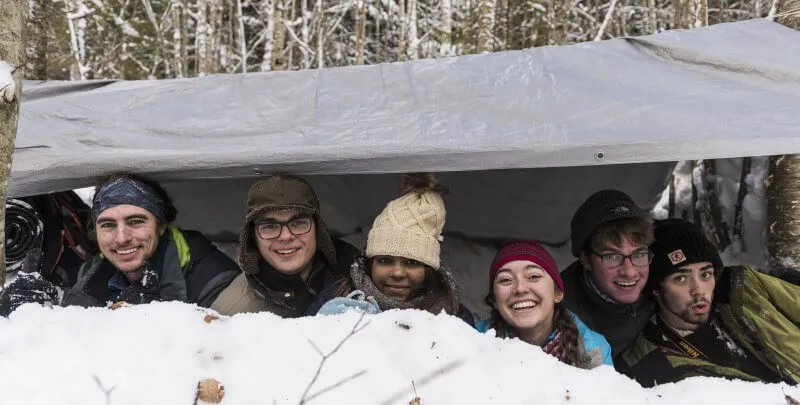It’s cold and sunny in the snow-covered woods of Camel’s Hump. Light snow dusts the plastic tarp toward which five people carry their immobilized, shivering friend. They set him down gently, remove his outer clothing and swaddle him in a sleeping bag and the tarp, creating a “hypo-wrap” to prevent hypothermia.
This is a mock rescue, one of many taking place in Camel’s Hump State Park this day as part of the Wilderness First Responder (WFR) course at UVM College of Nursing and Health Sciences. A few feet away and across the woods, several other groups are doing the same things – assessing injuries, carrying bodies and wrapping them in blankets. Throughout the daylong field session, they practice the skills they learned in their indoor classroom in UVM’s Rowell Building: splinting arms, checking vital signs, treating hypothermia, bandaging wounds, building shelters and making a litter, or simple stretcher, with saplings or ski poles and a tarp.
The class of 19 includes UVM students majoring in exercise science, wildlife biology, forestry, history and engineering. Four work as Vermont state game wardens taking the class as part of their jobs, for which they must maintain certification in Wilderness First Response. Another works for The Nature Conservancy leading backcountry hikes. Some class participants have completed or plan to take Emergency Medical Technician (EMT) training. All are passionate about the backcountry and thrive on outdoors adrenaline.
“These students do outdoor recreation with friends or family, and they want to be prepared,” said the instructor, Patrick Malone. “We have kids from across the campus who are taking these classes. This is a great life skills course.” Malone, who also teaches UVM’s EMT courses, has taught WFR since 1996. He sounds out the acronym, calling the course “woofer.”
WFR covers all manner of environmental emergencies, including swift water accidents, falling through ice, bullet wounds, bone breaks and lacerations suffered while hiking, hunting, skiing, rock climbing or diving into swimming holes. Lectures and discussions examine drowning, internal injuries, burns, heat stroke and winter survival. Guest presenters include representatives from the Vermont Backcountry Alliance, who describe common issues and emergencies for off-piste skiers and climbers.
Training to provide emergency care in remote settings helped Zach Klein ’19, Exercise and Movement Science, land his dream internship. Next summer he will intern with The Heroes Project, an organization trains and sends injured war veterans on mountaineering expeditions around the globe.
“This is exactly the type of job I want to have when I’m older,” Klein said. “I’m a snowboarder, climber, mountain biker and hiker. I am EMT certified but wanted to have my WFR so that I could improvise better in backcountry situations and become better educated in the subject.”
Some WFR students will pursue a minor in Emergency Medical Services (EMS), a new offering at the college. The WFR course provides three credits toward the 17 required for the minor.
Anita Paltoo ’18 biochemistry, plans to attend medical school and will minor in EMS. “I want to save lives. This course is the base level, and I want to work my way up.”
History major Billy Heath ’21, volunteers for Milton Rescue. “I’ll probably do the EMS minor. I like this stuff. I like being outside and serving my community,” he said.
“It’s a great way to get experience and do community service at the same time,” said Abby Knight ’21. She plans to minor in EMS and hopes to attend medical school. In between her studies, she skis, hikes and runs. “The WFR course combines my interest in the medical field and some of my favorite “day off” activities.”
UVM Wilderness Trek and the Outing Club require wilderness emergency medical training for their leaders. That’s why Shannon Bennett ’19 History took the WFR course. “I really like the wilderness, and I want to be an outing club leader,” she said. She plans to minor in EMS and apply to medical school. “I love hiking, backpacking, kayaking, canoeing and skiing. These passions, combined with my passion for medicine, inspired me to take the WFR course.”
Malone said the WFR and EMT courses are often pathways to health science professions. “We’ll have a student in a WFR class who may not know their career path. They will take WFR and it interests them, so they take the EMT class, and next they go into nursing or pre-med.”
Vermont state game warden Kyle Isherwood ’15 took the course to renew his WFR certification. He originally took WFR with Malone as an undergraduate wildlife biology student, and he has used the skills on the job --- responding to all-terrain vehicle accidents, pulling people out of frozen ponds, rescuing injured hikers.
As the field session wraps up, the students strap on snowshoes or click into skis and schuss down the mountain trail. Daylight has faded but the snow remains soft and fluffy. Everyone’s tired and happy -- it’s been a fulfilling day of academic work and practical application in a UVM classroom called wilderness.
